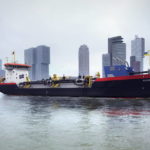In an interview with HANSA, Guus van der Bles, Managing Director Technology at Dutch Conoship, talks about details of the new LNG-fuelled dredger »Ecodelta«, challenges of the project and next steps
A dredger based on your design »LNG Dredger Ecodelta« is currently being built. What was the background of this[ds_preview] project?
Guus van der Bles: The order for the TSHD Ecodelta resulted from Conoship’s research and development activities on the feasibility of application of LNG as fuel for ships. This started already in 2003 with the design of the 1,100m3 LNG Carrier »Pioneer Knutsen«, the smallest sea-going LNG carrier at that time, fuelled by the LNG she carries. Through the years our research and development focussed on innovations that combine both eCONOmical and eCOlogical advantages, leading to our »eCONOlogical« ship designs. This was also our focus in research projects on the feasibility of LNG for short sea shipping, various retrofit-studies for cargo vessels to LNG propulsion and in 2013 the feasibility study »Dredging on LNG«. This study showed the high potential for LNG application in maintenance dredgers that work most of their time in ports.
Based on that research, we first received an order from dredging company Van der Kamp for a Research & Consultancy project on the feasibility of retrofitting their old maintenance dredger »TSHD Rijndelta« from diesel-electric propulsion to LNG-electric. This resulted in quite some possible advantages, but also technical challenges in the limited space of the existing dredger. After evaluation of the results, Conoship International got the order from Van der Kamp for Design and Engineering of a new 5,500m3 Dual Fuel Trailing Suction Hopper Dredger (TSHD) fuelled by LNG, the actual TSHD Ecodelta. The dredger is currently being built by Barkmeijer Shipyards in close collaboration with a consortium of companies in the northern part of the Netherlands.
What is the feedback from the industry on this design?
Van der Bles: Already during the R&D project »Dredging on LNG«, we experienced the high potential of LNG as fuel for maintenance dredgers. Conoship got involved in a project for the former German dredging company Möbius, and we developed a concept design for a 3,000m3 TSHD for maintenance dredging on LNG. Unfortunately the project was stopped when the dredging activities of Möbius were taken over by Strabag. Currently we are involved in various projects for dredgers on LNG: earlier this year we analysed a French maintenance dredger for retrofitting to LNG-electric dredging and propulsion and we are involved in numerous other projects for dredgers on LNG.
What have been the main challenges while developing the design?
Van der Bles: Designing dredgers for improving their performance is really challenging, as most dredging companies have their own specific ideas on working procedures, dredging equipment, areas and types of dredging work they specialize on.
The main challenge for the »TSHD Ecodelta« was the integration of the LNG tank of about 325m3 and the LNG systems, equipment and installation in the TSHD-design, in such a way that it is not limiting the optimal performance and dredging productivity of the vessel. This is also the case for design en engineering of the Dual Fuel (LNG & MGO) installation for the power supply for dredging and propulsion.
And what is the USP?
Van der Bles: The general Unique Selling Point is the reduction of the emissions of sulphur, NOx, CO2 and Sooth particles in exhaust gasses by fuelling on LNG. This is of special advantage for maintenance dredgers that are working a significant part of their time close to urban environments of harbour cities with lots of people and sometimes even in city centres where diesel cars have limited access to prevent air pollution. The operational focus of the TSHD Ecodelta is maintenance dredging in the port of Rotterdam, where she will be working most of the year.
During design and engineering, we cooperated very closely with the dredging specialists of Van der Kamp, integrating their requirements, wishes and ideas in the dredger’s design. The USP of the Conoship design is that all aspects of the vessel have been analysed and optimized for the specific operations of Van der Kamp. A special feature is the »oil skimming system« additional to the dredging system, for cleaning large oil spills from other vessels from the water surface in case of calamities along the Dutch coast. An innovative hopper construction was developed, improving the efficiency of the dumping of the soil. The dredger is designed for a rather high speed of 14kn, with a long and slender hull which is very special for a dredging vessel. Conoship optimized the hull lines and propulsion system for best fuel efficiency and minimizing emissions, based on extensive CFD analysis.
Do you expect any »game changer« in the dredging fleet in the coming years? Can we expect any follow-up on the current design?
Van der Bles: Dredging on LNG is expected to be the »game-changer« for maintenance dredging in ports. Conoship experiences a lot of interest in the design of LNG fuelled dredgers for this purpose, both from Europe and from Asia, for different sizes of Trailing Suction Hopper Dredgers and with different requirements than the TSHD Ecodelta.
What is your strategy for the future in general?
Van der Bles: Our strategy in general is increasing our Research & Development efforts focussing on application of practical innovations in our designs, improving our clients performance. We expect more focus on the »eCOlogical« aspects in our »eCONOlogical« designs, with the growing »sense of urgency for reducing emissions in exhaust gasses. Next to further development of LNG applications and other alternative fuels, we are developing an »eCONOwind Unit« for wind assisted propulsion on existing cargo vessels, for reduction of emissions and fuel consumption of 20% and more.
Interview: Michael Meyer
Michael Meyer





















